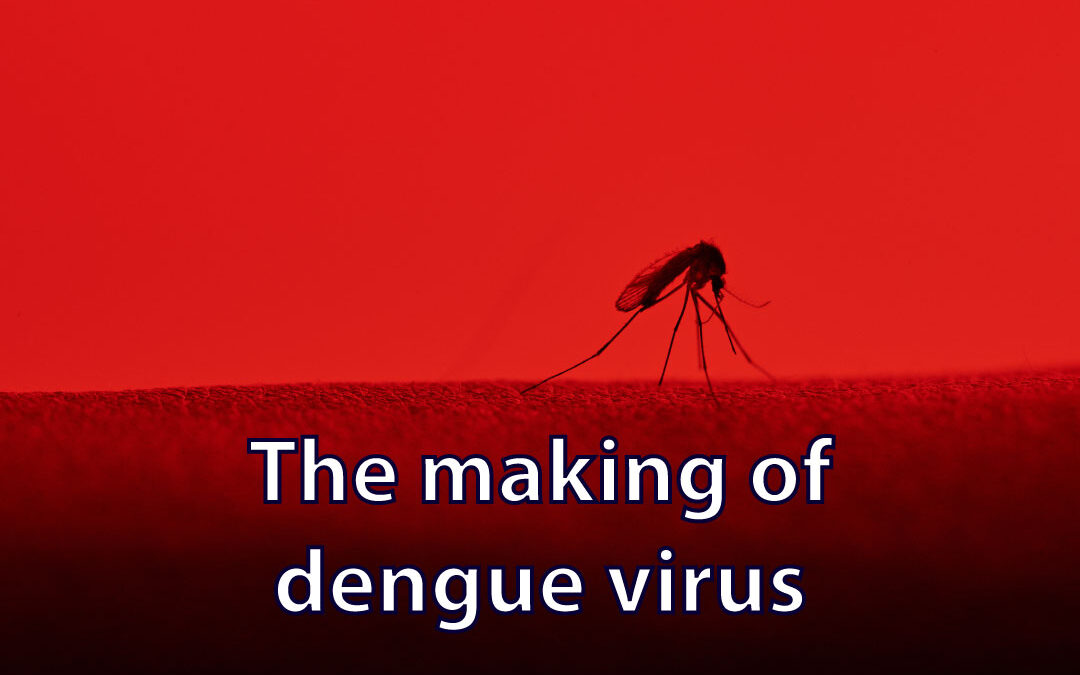The making of dengue virus
Dengue virus (DENV) belongs to the family Flaviviridae (genus Flavivirus) and is transmitted to humans by Aedes mosquitoes (mainly Aedes aegypti). DENV infection is usually characterized by fever and severe joint pain, but more serious syndromes – dengue hemorrhagic fever or dengue shock syndrome – can sometimes occur following dengue infection. Historically, dengue hemorrhagic fever was mostly confined to Southeast Asia. But dengue hemorrhagic fever has recently become endemic in Central and South America. This is a worrying trend. Also, because DENV is transmitted via mosquito vectors (Aedes aegypti and Aedes albopictus), if these vectors disperse more widely, DENV could also emerge in the warmer regions of Europe. There are four distinct serotypes of DENV, and hemorrhagic fever or shock syndrome are usually the result of sequential infection by multiple serotypes. There is currently no available antiviral against DENV and the only available anti-dengue vaccine shows limited efficacy against all serotypes and has raised serious safety concerns following the vaccination of DENV naïve children in the Philippines. A major strategic goal is to produce a multivalent vaccine against DENV that is equally effective against the four serotypes. This is because vaccines effective against only single serotypes (or not uniformly effective against different serotypes) will likely increase the risk of antibody-dependent enhancement when immunized individuals are subsequently infected by a different serotype.
The dengue life cycle
DENV is an enveloped virus with a single-stranded, positive–sense RNA genome. The 11-kb DENV genome contains a single ORF that encodes a polyprotein precursor of more than 3,000 residues. Following receptor-mediated endocytosis of the virion and fusion with the endosomal membrane, the viral RNA (vRNA) is uncoated and released into the cytosol. Alternatively, DENV can opsonize with non- or sub-neutralizing levels of antibodies, allowing entry into target cells (e.g., monocytes, macrophages, and dendritic cells) through the Fc gamma receptors. This infection pathway, termed antibody-dependent enhancement of DENV infection (ADE), is an important mechanism in the pathogenesis of severe dengue. After entry, an initial round of translation is necessary to produce all of the viral proteins required for the initiation of viral synthesis and subsequent amplification. Like other flaviviruses, DENV induces massive rearrangements of ER membranes to create a replicon-favorable microenvironment for viral RNA synthesis. Translation of the viral RNA occurs at the surface of the ER and results in the synthesis of a highly membrane-associated polyprotein product, which is subsequently processed by both cellular and viral proteases to generate ten mature viral proteins. Structural proteins Capsid (C), Envelope (E), and prM assemble new viral particles, while the non-structural proteins (NS1, NS2A, NS2B, NS3, NS4A, NS4B, NS5) are responsible for vRNA replication and membrane remodeling. The neosynthesized viral RNA is then encapsidated into an assembling viral particle which buds into the ER. Assembled viruses egress through the secretory pathway and infectious virions are released via exocytosis.
vRNA translation: in the beginning, there was Cap
Like cellular messenger RNAs, the DENV genome contains a cap structure at the 5 ′ end, which enables translation through canonical cap-dependent translation initiation. The addition of the cap is mediated by the joint activity of NS3 and NS5: NS3 removes a phosphate from the 5′ terminus of the vRNA. Next, the NS5 methyltransferase activity catalyzes the transfer of a guanosine monophosphate (GMP) moiety from GTP to the RNA (G5′-ppp-5′A). Finally, NS5 catalyzes the methylation of this guanine on N7 and the ribose-2’ OH of the first adenosine to form a type 1 cap structure (N7MeG5′-ppp-5′A2’OMe). Addition of the cap moiety to the 5′ end of the viral genome is crucial: this structure ensures efficient production of viral polyproteins by the host translation machinery, protection against degradation from cellular 5′-3′ exoribonucleases, and evasion of the host innate immune response (the process of capping removes the triphosphorylated [or dephosphorylated] end from recognition by host cell innate immune sensors). It is noteworthy that, unlike cellular mRNAs, vRNA lacks a 3′poly-A tail. The poly A tail is typically important for stability and to stimulate translation initiation of cellular mRNAs. Despite the lack of a poly-A tail, the 3′ end of DENV RNA can associate with poly-A-binding protein (PABP), which in eukaryotes stimulates translation initiation by binding simultaneously to the mRNA poly(A) tail and the cap-binding protein eukaryotic translation initiation factors. Despite its presumed dependence on cellular translation factors, DENV has been shown to infect differentiated cells, such as those of the myeloid lineage, which are known to contain limiting amounts of translation factors. Under cellular conditions in which translation factors are limiting, the DENV genome can also be translated through a noncanonical mechanism that appears not to require a functional m7G cap structure. Usually, cap-independent translation initiation is achieved using an internal ribosome entry site (IRES), examples of which are found in the 5′ UTR of the genomes of picorna- and hepaciviruses. The DENV noncanonical translation is not mediated by an IRES but instead requires the interaction of the 5′ and 3′ UTRs. In response to different cellular conditions, the use of distinct structures located in the viral 5′ and 3′ UTRs allows DENV to alternate from standard cap-dependent translation to a form of noncanonical alternative translation initiation. This means that DENV translation is entirely controlled by the structure of the genome itself. What else might be orchestrated by a simple RNA molecule? Look out for the next VRS blogs, as in later episodes we will review the RNA structures that constitute DENV. We believe that it is only through a detailed functional understanding of the flaviviral genome that it will become possible to appreciate the evolution and fitness mechanisms of DENV, and ultimately design effective therapeutics.
Enjoying Virus of the Month? Subscribe to the VRS Newsletter for monthly virus news and views. Next month, we’ll describe a few instances of how DENV has optimized its genome.




